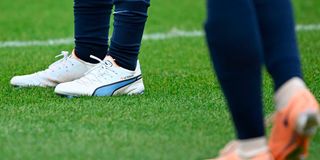Report: Men’s boots injuring female football players

England defender Maya Le Tissier's (left) boots are pictured during a team training session at St George's Park in Burton-on-Trent, central England, on June 27, 2023 ahead of their women's international friendly football match against Portugal on July 1.
What you need to know:
- Moreover, the boots currently on the market are largely designed for white males.
A kind friend recently shared findings of a new research that confirmed a fact I have known all along – when it comes to sports, one size doesn’t fit all.
The research was conducted by the European Clubs Association, a body that represents the interests of professional association football clubs in Uefa, and it revealed that more than 80 per cent of female players at top European clubs have suffered regular discomfort because of their football boots.
Moreover, the boots currently on the market are largely designed for white males.
Forget the part on race. Let’s stick on the gender division. The findings mean that majority of female footballers are enduring discomfort which could affect their performance.
Only a fifth of those interviewed said they had customised their boots in an attempt to improve comfort.
What’s interesting is that research has long suggested that anterior cruciate knee ligament injuries – the most serious kind of knee damage – are more prevalent in elite female footballers than in males.
In a research paper published in September last year in the journal titled Sports Engineering, Tottenham Hotspur club doctor Craig Rosenbloom wrote that ACL knee injuries are at least twice as common in elite female footballers when compared to male footballers.
In a podcast recorded in April this year, Dr Katrine Okholm Kryger, a senior lecturer in sports medicine who specialises in football, said recent discussions have focused on whether the injury risk is related to the female anatomy and hormones, or whether it could be about the way female athletes are raised and managed compared to male athletes. Perhaps we now have our culprit?
The new data, collected from a survey of 350 anonymous players from 16 top-tier teams, showed that it is in the heel area where the discomfort is greatest.
Those who couldn’t afford to customise their boots reported using insoles provided by podiatrists, and some players actually needed to cut holes in their boots to avoid persistent rubbing and blisters.
In short, the boots on the market are largely designed for males. Reading the findings, I was greatly impressed by my friends from the West for staying committed to expanding everyone’s knowledge on football equipment and clothing which enhances safety, performance and comfort for female athletes.
How lovely is it that someone has found it important to explore differences between female and male feet, including width, height of arches, metatarsal length, joint angles and ankle circumference relative to foot length?
What’s not impressive is the fact that despite so much progress in women’s football (at least in Europe), and despite widespread knowledge in the biological differences between men and women, no large boot manufacturer has invested in a design to suit women.
You won’t find this full report on female football boots online because it is yet to be peer-reviewed and published, but the summary is that the wearing of boots designed for men is causing blisters and stress fractures in elite female players for the simple reason that women move and run in a different way to men, and the length of studs on boots are designed around male movement and traction.
Ahead of the Women’s World Cup 2023, one hopes that this research will soon become freely available to all football boot brands to help create female-specific designs.





